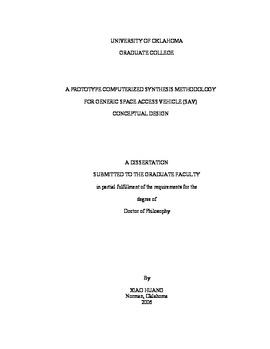| dc.contributor.author | Huang, Xiao. | en_US |
| dc.date.accessioned | 2013-08-16T12:20:08Z | |
| dc.date.available | 2013-08-16T12:20:08Z | |
| dc.date.issued | 2006 | en_US |
| dc.identifier.uri | https://hdl.handle.net/11244/1036 | |
| dc.description.abstract | This dissertation presents the development steps required towards a generic (configuration independent) hands-on flight vehicle conceptual design synthesis methodology. This process is developed such that it can be applied to any flight vehicle class if desired. In the present context, the methodology has been put into operation for the conceptual design of a tourist Space Access Vehicle. The case study illustrates elements of the design methodology & algorithm for the class of Horizontal Takeoff and Horizontal Landing (HTHL) SAVs. The HTHL SAV design application clearly outlines how the conceptual design process can be centrally organized, executed and documented with focus on design transparency, physical understanding and the capability to reproduce results. This approach offers the project lead and creative design team a management process and tool which iteratively refines the individual design logic chosen, leading to mature design methods and algorithms. As illustrated, the HTHL SAV hands-on design methodology offers growth potential in that the same methodology can be continually updated and extended to other SAV configuration concepts, such as the Vertical Takeoff and Vertical Landing (VTVL) SAV class. Having developed, validated and calibrated the methodology for HTHL designs in the 'hands-on' mode, the report provides an outlook how the methodology will be integrated into a prototype computerized design synthesis software AVDS-PrADOSAV in a follow-on step. | en_US |
| dc.description.abstract | Today's and especially tomorrow's competitive launch vehicle design environment requires the development of a dedicated generic Space Access Vehicle (SAV) design methodology. A total of 115 industrial, research, and academic aircraft, helicopter, missile, and launch vehicle design synthesis methodologies have been evaluated. As the survey indicates, each synthesis methodology tends to focus on a specific flight vehicle configuration, thus precluding the key capability to systematically compare flight vehicle design alternatives. The aim of the research investigation is to provide decision-making bodies and the practicing engineer a design process and tool box for robust modeling and simulation of flight vehicles where the ultimate performance characteristics may hinge on numerical subtleties. This will enable the designer of a SAV for the first time to consistently compare different classes of SAV configurations on an impartial basis. | en_US |
| dc.format.extent | xxv, 324 leaves : | en_US |
| dc.subject | Engineering, Aerospace. | en_US |
| dc.subject | Space vehicles Design and construction. | en_US |
| dc.title | A prototype computerized synthesis methodology for generic space access vehicle (SAV) conceptual design. | en_US |
| dc.type | Thesis | en_US |
| dc.thesis.degree | Ph.D. | en_US |
| dc.thesis.degreeDiscipline | School of Aerospace and Mechanical Engineering | en_US |
| dc.note | Source: Dissertation Abstracts International, Volume: 67-03, Section: B, page: 1540. | en_US |
| ou.identifier | (UMI)AAI3212013 | en_US |
| ou.group | College of Engineering::School of Aerospace and Mechanical Engineering | |
